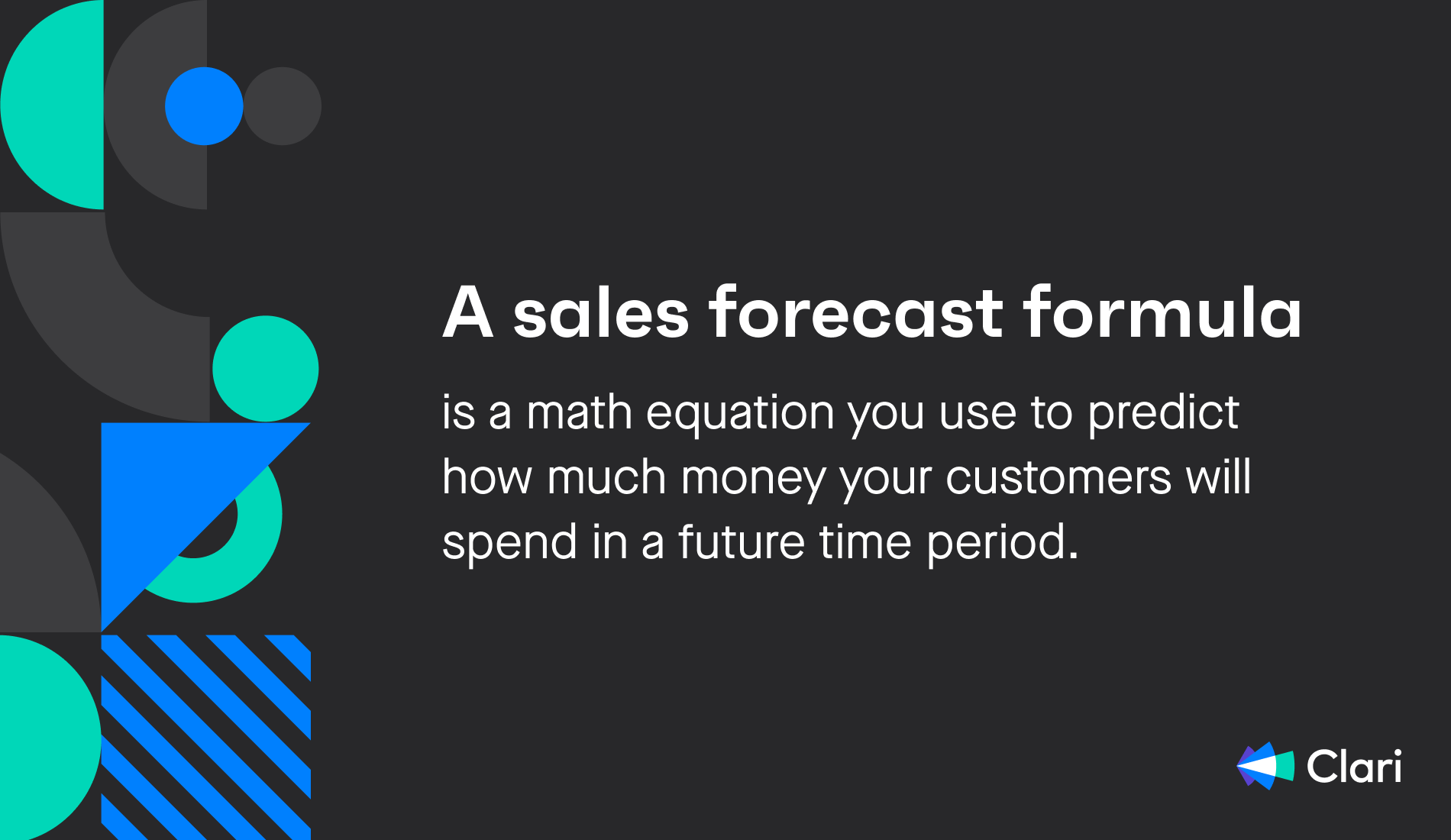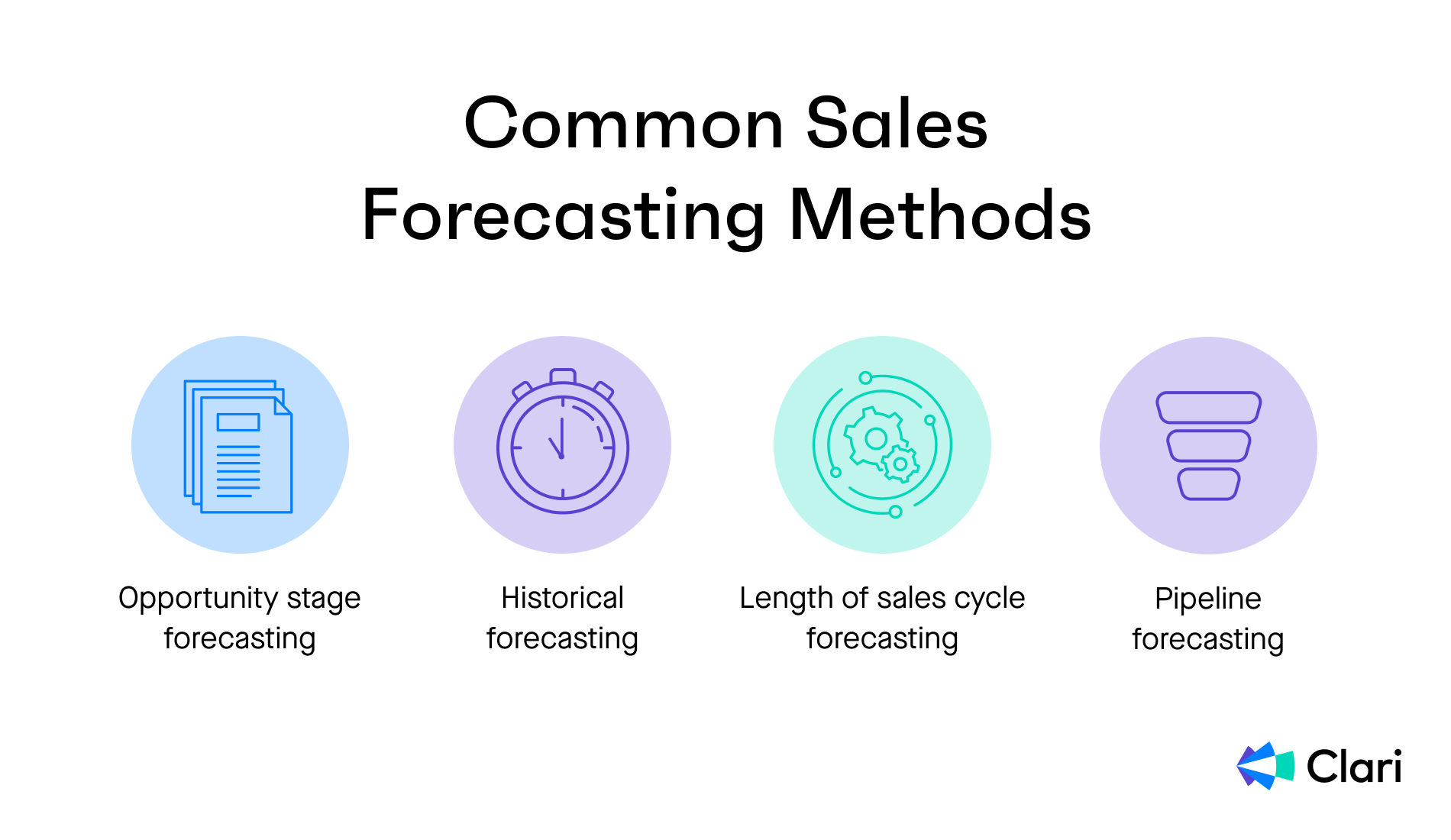Trying to predict your business’s future?
A sales forecasting formula may not be a crystal ball, but using one can help you plan your revenue strategy.
Why is sales forecasting important?
If you don’t know what’s ahead, you won’t know how to plan your revenue activities.
By leveraging the right sales forecasting formulas, you’ll be able to see what’s ahead and make the right moves to grow your revenue.
In this guide, you’ll learn all about sales forecasting formulas: what they are, the different types, how they work, and some practical examples so you can start planning your revenue strategy today.
Table of Contents:
- What is a sales forecast formula?
- Why is it beneficial to use formulas for sales forecasting?
- What data is typically needed to use sales forecast formulas?
- The sales forecasting method you choose will determine the formula
- 4 Key formulas for sales forecasting
- Using Excel for sales forecast formulas
- Examples of sales forecasting calculations
- Use Clari Forecast to predict and grow your revenue
What is a sales forecast formula?
You need to establish a proper forecast to plan for your business’s future.
A sales forecast formula is a math equation you use to predict how much money your customers will spend in the future.

How do you calculate it?
Simply multiply the number of customers you expect to do business with next month (or quarter or year) by how much money they’ll spend on your products and services.
For example, if you have 72 new customers next month, and they’ll spend an average of $1,950, the equation looks like this:
72 x $1,950 = $140,400.
So, you’re forecasting $140,400 for the next month.
Sounds easy, right?
The basic formula is simple, but many details and nuances are involved in coming up with an accurate forecast for your specific business.
That’s why there are several types of sales forecasting formulas.
For example, there are dozens of external factors that can impact your future revenue:
- Seasonality
- Market fluctuations
- Global economic conditions
- A good (or bad) review by a large customer
Not all external factors may be a bad thing for your company. There may be positive trends that explode your revenue from time to time.
So, how do you plan for fluctuations? How do you confidently tell your sales reps and revenue teams what activities and campaigns they should work on?
By relying on accurate sales forecasting.
Even if external factors impact your sales occasionally, you can leverage forecasting to weather those fluctuations better.
Why is it beneficial to use formulas for sales forecasting?
Sales forecasting formulas are crucial to reaching your sales goals every month, quarter, and year.
Maintaining accurate financial records
While sales forecasting can help you grow revenue, the most important benefit is the impact on your financial records. With proper forecasting, you can ensure your books are clean, accurate, and predictable to keep your business in good health.
Staying within budget
With better books, you’ll not only be able to predict future sales, but you’ll also be able to properly forecast future expenses. If you know you’ll likely have lower sales next month, you can keep your budget lower.
Improving inventory management
Sales forecasting can help your sales leaders manage your inventory better so you’re not overordering inventory that may not be sold next month.
Following the laws of the land
Compliance is key with forecasting. Since sales forecasting can help you maintain good books, you’ll be less likely to get audited.
Growing revenue
The sweetest side effect of better forecasting is your ability to grow your revenue. When you can predict future revenue, you can plan the correct actions to reach your sales target.
What data is typically needed to use sales forecast formulas?
There are several ways to forecast future sales, but here are a few common data points:
Historical leads
Your historical leads are all the leads you get at stage one of the sales process.
These are the total (unqualified) leads in your pipeline that you haven’t contacted or filtered yet.
Historical leads contacted
Once you have leads placed in your pipeline, it’s time to qualify those leads. The best way to do that is by reaching out via:
- Phone
- DM
You need to ensure you follow up with your leads as soon as possible (once they enter your pipeline), or you could lose them.
Historical leads qualified
Another key data point in generating an accurate sales forecast formula is the leads you’ve qualified. You’ve contacted these leads and gathered more information from those who could be a good candidate.
Historical leads with proposals sent to them
Once you’ve qualified leads, it’s time to send proposals to them. If you want to make the sale, you need to first make the ask.
Number of leads converted to customers
Your historical sales are broken down by the number of leads you’ve officially turned into paid clients or customers.
Ultimately, this data point is the greatest predictor of future sales.
The sales forecasting method you choose will determine the formula

There are a few common sales forecasting methods:
Opportunity stage forecasting
Opportunity stage forecasting is a common method that analyzes the volume of leads in certain pipeline stages. The idea is that the more leads you have in the pipeline, the more deals you will close.
On the one hand, it’s one of the easiest forecasts to set up, and the calculations are simple.
On the other hand, any bit of inaccuracy in data can lead to poor forecasts. The calculation also doesn’t consider each lead's size (or even the age).
Historical forecasting
Historical sales forecasting is one of the most popular sales forecasting methods. Simply look back at a previous time period to determine future results.
One upside to this is that it’s another easy forecasting method. For example, you could take what you got last year and predict that it will happen again with your annual sales forecast.
One downside is that it doesn’t account for seasonality or market fluctuations.
Length of sales cycle forecasting
Length of sales cycle is another forecasting strategy that looks at the age of certain deal opportunities to forecast when they’re likely to finalize as a deal.
One positive with this method is that it relies on objective data rather than sales team feedback.
But you need to ensure you’re carefully tracking exactly when our leads come into your sales funnel for this method to work well.
Pipeline forecasting
The final method to calculate sales forecasts is pipeline forecasting. It works by reviewing each opportunity in your pipeline and giving you a prediction of the chances of you closing it.
This method is great for helping analyze the likelihood of deals closing. However, it’s challenging to calculate, especially if you aren’t using a sales analytics tool with accurate data.
4 Key formulas for sales forecasting
Now that you know which forecasting methods to choose from, it’s time to dive into their formulas:
Opportunity stage formula
Once you have your reporting period (i.e., the previous month or year), multiply each deal’s (potential) value by the probability it will close.
Historical formula
This is the simplest formula. If you want to forecast next month’s revenue, all you have to do is look at the previous month.
The same works for analyzing future weeks, quarters, or years.
Length of sales cycle formula
How long does your average sales cycle last?
Multiply that number by how long your sales team has been working on a deal.
Pipeline formula
With pipeline forecasting, you simply look at every opportunity in your sales pipeline and analyze the likelihood of closing it.
Using Excel for sales forecast formulas
Wondering how you can start forecasting your sales?
The simplest way to start is with an Excel spreadsheet.
1. Create a new Excel sheet
Open Microsoft Excel and click “New” to launch a new spreadsheet.
2. Create your forecast
Pick your forecasting method and insert the data into Excel.
You can use straight line, moving average, and simple linear regression sales forecasting formulas with Excel.
3. Adjust your sales forecast
You need to keep updating and adjusting your forecast every day or week. New opportunities come along (and fall apart), so you should update it regularly.
4. Review your sales forecast
Every week, month, quarter, and year, you should review your sales forecast to analyze how many deals are coming in so you can adjust your sales strategy.
Remember, you can use Excel or Google Sheets to forecast your sales.
For more robust sales forecasting, try Clari today.
Examples of sales forecasting calculations
Curious how a sales forecasting calculation works?
Here are a few examples of how you can calculate these formulas:
Opportunity stage example calculation
Let’s say you determined the following likelihood to close at the qualified lead stage is 15%, and the average potential value of each deal is $12,000.
This means each deal’s forecasted amount is $12,000 x 15% = $1,800.
Historical example calculation
If you generated $120,000 in revenue last month, you can predict the same for next month.
You can add historical growth data if you want to make it a bit more sophisticated. For example, if you grow at 5% each month, you could calculate $120,000 x 1.05 = $126,000.
Length of sales cycle example calculation
Let’s say your average sales cycle is two months.
Your sales rep has been working on a deal for half a month, which means you could say they’re 25% likely to close the deal.
Pipeline example calculation
For example, if you have 30 deals in your sales pipeline, split equally between 3 reps.
Each rep has a different close ratio. Add up the likelihood of them closing each deal by the amount in each deal.
Breaking it down:
Rep 1: 20% close ratio and $20,000 total potential revenue = $4,000
Rep 2: 15% close ratio and $40,000 total potential revenue = $6,000
Rep 3: 12% close ratio and $33,000 total potential revenue = $3,960
Forecast = $13,960
Use Clari Forecast to predict and grow your revenue
You have the power to keep growing your revenue.
But, without knowing what’s ahead, knowing how you should strategize is hard.
With sales forecasting formulas, you can calculate your future revenue, which can help you adjust course and develop new revenue growth plans.
There’s no greater sales forecasting tool than Clari.
Clari Forecast gives you an accurate view of your revenue future with the tactical insights to get there. Many Clari customers are seeing as much as an 11% increase in win rates when they start using Clari Forecast.
Book a demo of Clari today.



